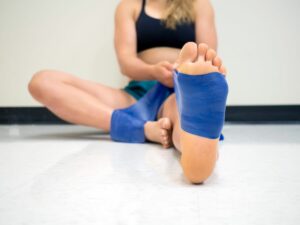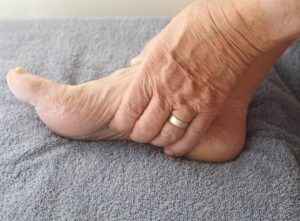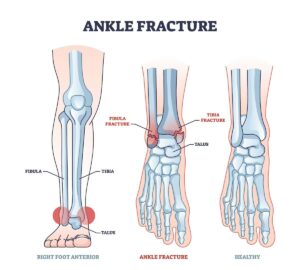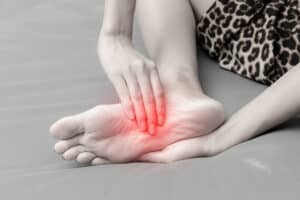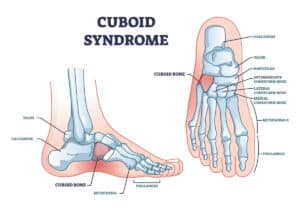Free download: Top 10 Natural & Easy Remedies for Joint Pain from Home. Learn these helpful remedies.
Estimated Reading Time: 12 minutes read
Calf strain is one of the most common runner’s injuries. It happens when you overwork your calf muscles. They can become strained after running, skating or dancing for long periods, or after doing exercises such as backward leaps or uphill running.
Right as you are starting your new workout, you notice a sharp pain in your calf! Great. You’ve just experienced a calf strain, what can you do? Will you even be able to keep your New Year’s resolution?’
Table of Contents
Who Can Be Affected by a Calf Strain?
We don’t have to be ultra runners to experience muscle strains. We can experience a calf strain simply from walking, or tripping, or speeding up suddenly.
This can be a real pain in the… calf. Especially because once you have a calf strain you now have pain just then you walk!
Risk factors for a calf strain include:
- Tight calf muscles – and trust me, your calf muscles probably are tight.
- Not warming up your muscles before exercising.
- Sudden burst of movement – not just sprinting, have you ever rolled your ankle over the sidewalk edge? That’s also a sudden burst of movement to your ankle and calf!
- A history of calf strains – remember that old track injury? Old injuries can come back to haunt us if we do not keep up with stretching and strengthening.
There is always the R.I.C.E. method to help with rehab for a muscle strain, but let’s go a step further to explore some exercises for a calf strain.
Performing these exercises can help not only heal a calf strain but also prevent one from occurring again!
Anatomy of Your Calf
Our calf is made up of two muscles, the Gastrocnemius muscle and the Soleus muscle. Our Gastrocnemius is like the big brother of the two and is the main muscle you feel when you touch your calf. This muscle not only helps point your toes but also helps to bend your knee.
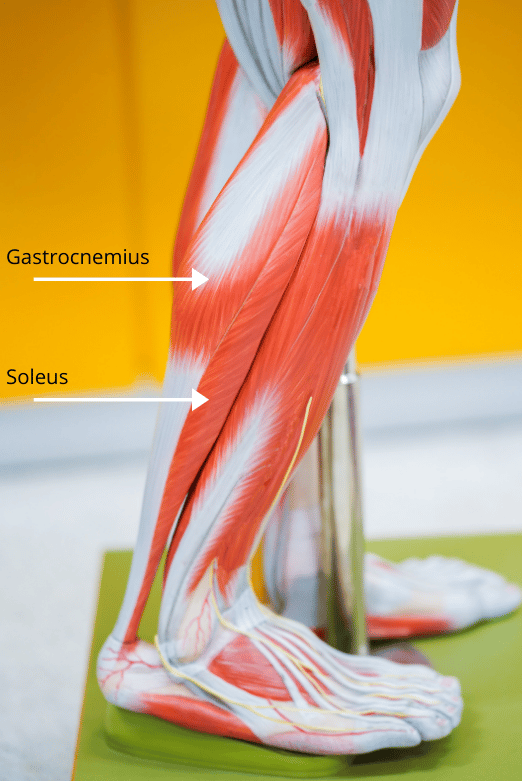
The Soleus muscle is deeper and is like the little brother. Because it’s smaller it does not do anything to your knees, but it does help point your toes.
These muscles are major players when it comes to walking. They not only help control ankle movement but also help when you push off the ground with your foot when walking.
Their role in walking is why you feel pain with each step following a strain.
What Technically is a Calf Muscle Strain?
A strain (or sometimes referred to as a pulled calf) occurs when the muscle fibers are stretched to the point that they tear. A tear ranges from a few muscle fibers (think of it as an overstretched rubber band) to a complete tear in your muscle (snapped rubber band).
Muscle strains are classified into three grades depending on how bad the tear is.
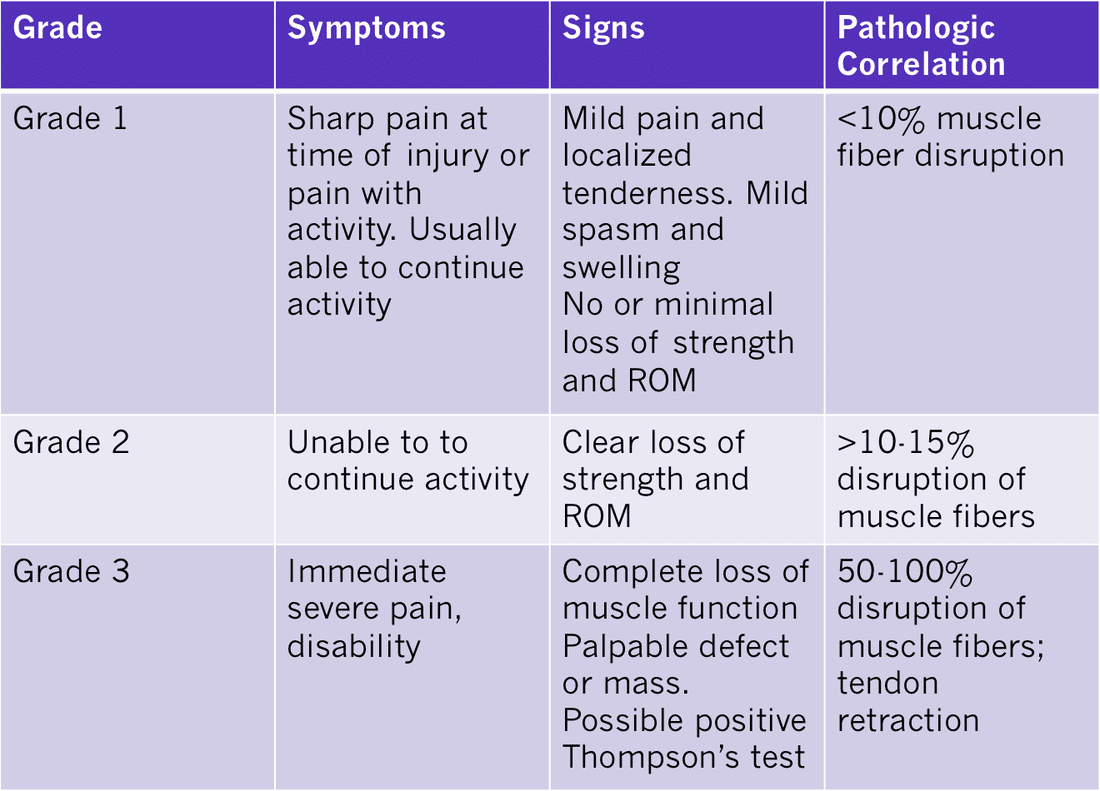
Grade I Strain
While not great, this is the best strain to have. This is a mild strain, where only a small portion of the muscle is stretched or torn. There is pain when walking, but you may not even have a noticeable limp.
Grade II Strain
This is a moderate strain, with a greater number of injured muscle fibers and more severe muscle pain and tenderness. You are likely to have a limp after a grade II strain.
Grade III Strain
This occurs when your muscle experiences a full-thickness tear, which is a complete tear of the muscle. Here are some key ways to know if you have a grade III strain:
- When the muscle tears it will sound like a gunshot going off with a loud “pop” because of all the tension through the muscles.
- Remember how these muscles help you point your toes? If the muscle tears, you will no longer be able to point your toes or push off from the ground with your foot.
- You will experience significant swelling and bruising in your calf.
- There may be a dent in your calf because the muscle separates after it tears.
If you think you’ve experienced a Grade III strain, call your primary care physician or go to Urgent Care.
There are ways to treat this without surgery, but you want to make sure you speak to a physician about treatment options rather than waiting it out or walking it off.
How to Tell if You Have a Calf Strain
Here are some key indicators for a calf muscle strain:
- Pain when walking
- Stiffness in the calf muscle
- Weakness of the calf muscle
- Bruising on the calf
- A popping sensation as the muscle tears
You can also give yourself this quick test:
Stand with your feet together. Hold onto the back of a chair or the counter. You will perform this one leg at a time:
- On your non-injured leg, perform a heel lift so you’re on the ball of your foot.
- Next, perform a heel lift on your injured leg.
Are you able to perform the movement on your injured leg? Do you feel pain? If the movement was challenging or painful it’s time to perform rehab your calf strain!
But first, you may want to consider if your pain is coming from Achillies Tendonitis or a rolled ankle. These conditions tend to cause pain closer to the ankle.
Phase 1: Rest, Ice, and Massage
This is where you want to start, especially if your injury is less than two weeks old.
Rest: Pause exercises that increase calf pain. Depending on the level of strain you may still be able to perform some exercises, but use pain as your guide.
REMEMBER the muscle is injured so feeling pain when you perform an exercise means you may be injuring the muscle more!
Give that muscle rest so it can heal properly.
Ice: Ice helps with inflammation, and after a tear, that muscle will be inflamed. Ice isn’t the most comfortable thing to use, but try to hold ice on your calf for five minutes at a time to help with all that swelling and inflammation.
Controlling inflammation will help the muscle tissue heal faster and will help you get back to your daily exercises – or New Year’s resolution – faster.
Massage: Help relax those muscle fibers and break up adhesions with massage.
Begin with a “figure-four” position – also known as making yourself into a pretzel. Once you are in that position use your thumbs to do slow deep circles along your calf.
This will be uncomfortable, but should not be so painful you want to cry or jump out of your chair. You want it to be a hurts-so-good vs a hurts-so-bad. When in doubt, go lighter and then gradually increase pressure over the next two weeks.
If pain improves after performing rest, ice, and massage for a week then you are ready to graduate to phase two!
Phase 2: Strengthening
Two weeks after a strain – and with an improvement in pain – you are ready to introduce strengthening exercises for a calf muscle strain! Strengthening your calf is critical to performing weight-bearing exercises – like walking – without pain again.
Notice that this is strengthening, not stretching. Your calf will not be ready for stretching just yet so it’s important to keep to just strengthening in this phase.
Strengthening Exercises for Calf Strains
1. Seated Calf Raises
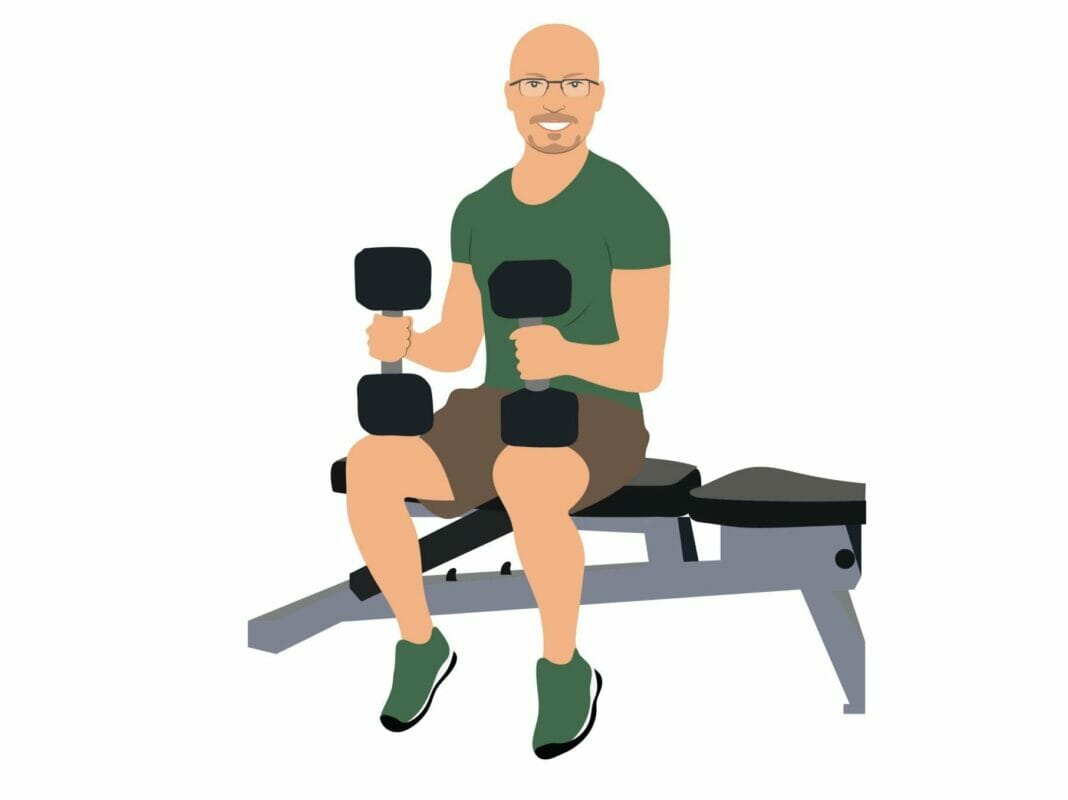
This exercise is great for allowing you to strengthen your calves without using your full body weight yet.
Start in a seated position. Then, use your hands to gently press through your knees to add resistance. While adding resistance lift both of your heels.
You can also use weights, soup cans, or even wine bottles as resistance. Hold the weighted object on your knees then lift your heels.
Just remember, let your pain be your guide! Start slow and gradually increase weight and resistance.
Repeat 10 times slowly.
2. Floor Calf Raises
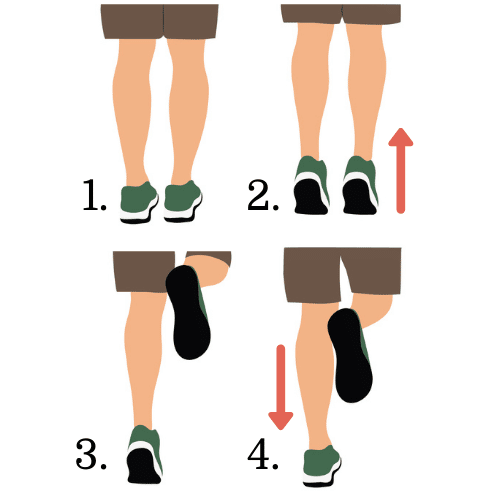
This one seems tricky at first glance, but once you find the rhythm you will be able to move through this like an old dance routine!
Start by rising up into your toes with both feet. Then, pick up your pain-free leg so you are just standing on your injured leg. The final step is to slowly lower the heel of your injured leg until your heel is on the floor.
This is eccentric strengthening: when a muscle contracts then slowly lengthens under resistance. Eccentric training is an important way to build up strength when performing rehab for a calf strain.
Repeat 10 times slowly.
3. Calf Raises from a Step
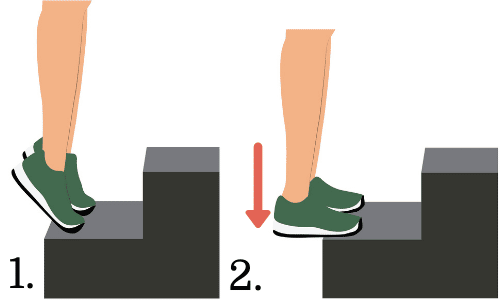
Now that you have perfected the dance routine that is eccentric calf raises on the floor, time to move onto eccentric calf raises on a step.
Don’t worry, this exercise is actually simpler than the last one, it’s just a harder strengthening exercise because the step allows for a greater range of motion in your calf.
For this exercise stand on a step with both of your heels off the edge. Don’t forget to perform this exercise on the bottom step only and to hold onto a railing.
The last thing you want to do when trying to fix a calf strain is to fall and increase the calf strain!
Once you are sure that you are balanced and secure on that step, push up onto your toes with both legs.
The key to making this eccentric strengthening is to slowly lower both of your heels on a count of 5.
Essentially it should look like: up onto your toes on a count of one, and then slowly lowering your heels on a count of 5. Don’t rush lowering your heels down!
Repeat 10 times slowly.
Level up BONUS: Calf Stretching
Great job! You have rested, iced, massaged, and strengthened your calf till it has healed. You no longer have significant pain when walking, but you do feel some stiffness.
This means you have collected all the coins and are ready to level up to the BONUS level!
If you still have pain keep working on the first two phases! Don’t rush yourself!
This extra phase will help you reduce the risk of the injury occurring again and is important for a full and complete rehab of a calf strain.
Remember how we talked about how there are two calf muscles? That means there are two stretches we want to perform!
1. Bent Knee Calf Stretch
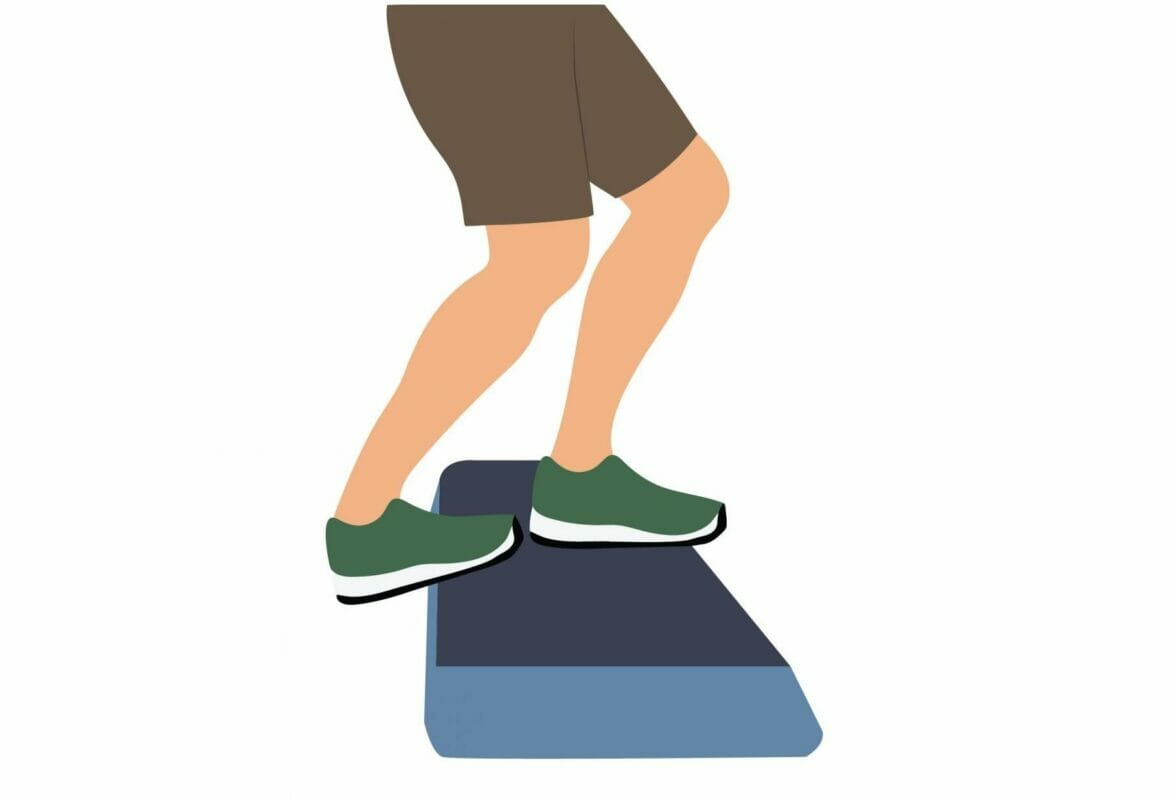
This stretch has a bent knee because Soleus – the little brother muscle – only works on the ankle. Therefore, in order to isolate just the ankle for this stretch, you need to bend your knee.
Start by standing with your injured foot halfway off the edge of a step. Don’t forget to hold onto a railing when performing this! Bend your knee and drop your heel down.
You should feel a stretch in the back of your calf. Hold for 30 seconds x 3 on both sides.
2. Straight Knee Calf Stretch
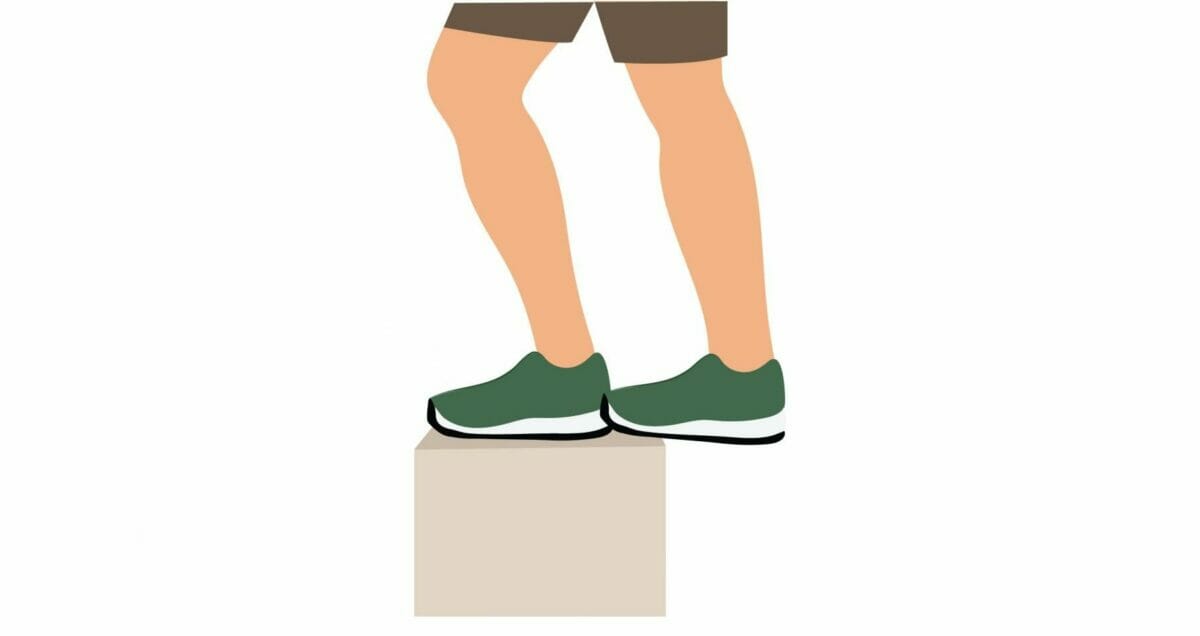
This stretch has a straight knee because Gastrocnemius – the big brother muscle – works on the ankle and knee. Therefore, you want to include both in order to stretch the entire Gastrocnemius muscle.
Start by standing with your injured foot halfway off the edge of a step. One again, don’t forget to hold onto a railing when performing this! Straighten your knee and drop your heel down.
You should feel a stretch in the back of your calf and even possibly behind your knee. Hold for 30 seconds x 3 on both sides.
How Often Should You Exercise Your Calves?
Try incorporating calf exercises into your workouts a couple of times a week! Remember, since you have experienced a calf strain you are at risk of experiencing another one.
Keep up with stretching and strengthening exercises for a calf strain to help prevent one from occurring again.
A great time to add in calf strengthening is when washing dishes! You can perform heel raises, or even better, eccentric heel raises while standing at your sink! It’s all about multitasking, just don’t forget to wash all the food off a dish!
Rehab For Calf Strain Recovery Time
Recovery time varies based on the classification of your strain. In general, recovery is about six weeks. At that time mature collagen tissue has formed and you are able to return to your normal activities.
Don’t forget to check in with your doctor before returning to your activities or before starting a new workout routine to meet your New Year’s Resolution.
It’s better to make sure you have all your ducks in order before starting that new running routine again.
The biggest thing that will improve your chances of being healed by six weeks is sticking to the rehab for a calf strain program.
Can Calf Strains be Prevented?
There are several ways you can help prevent a calf strain:
Don’t dive right into a new workout routine! Gradually introduce new exercises and slowly increase the intensity of those exercises.
Always warming up before starting a sport or heavy physical activity.
Following a consistent strength and flexibility/stretching exercise program to maintain good physical conditioning, even in a sport’s off-season.
Wearing shoes that are in good condition and fit well.











